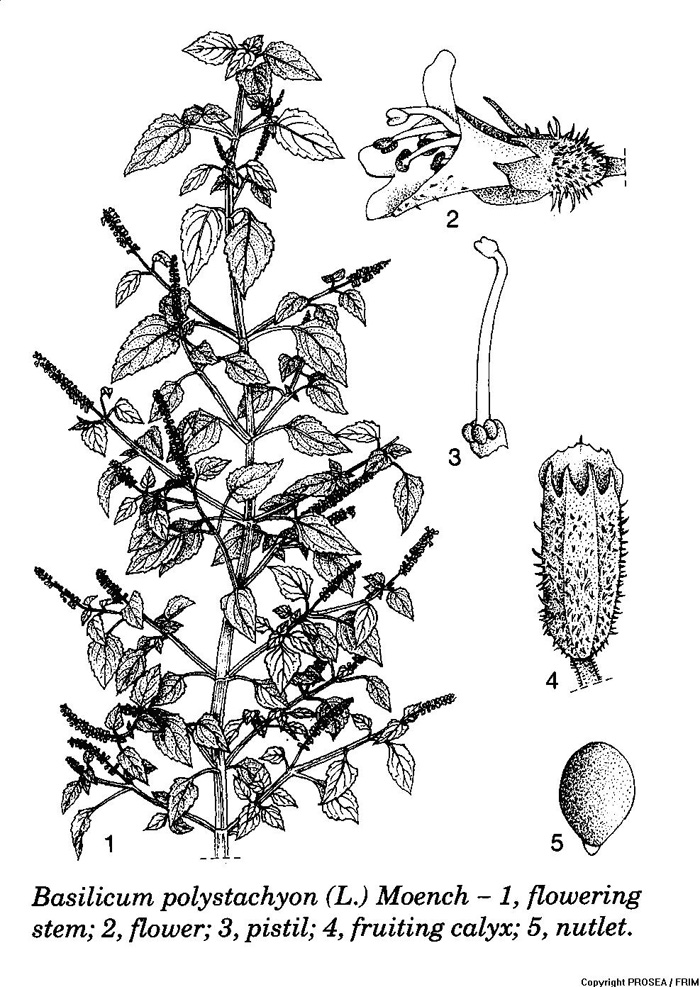Basilicum polystachyon (L.) Moench
Family
Labiatae
Synonyms
Ocimum polystachyon L., Moschosma polystachyon (L.) Benth.
Vernacular Names
| Malaysia | Tapua jatten |
| English | Musk basil |
| Indonesia | Sangketan (Javanese), surawung gunung (Sundanese) |
| Philippines | Pansi-pansi (Tagalog), bauing (Magindanao), lodokong (Pangasinan) |
| Vietnam | [es] gi[ar], [es] s[aj], m[ooj]c ma |
| French | Basilic musque |
Geographical Distributions
Tropical Africa through India, the Mascarenes and Sri Lanka to South-East Asia and tropical Australia.
Description
This is an erect, annual to short-lived perennial, aromatic herb that can reach a height of between 40-100 cm. Its stem is much branched, prominently 4-angled and nearly smooth. Leaves are decussate, ovate to oblong-ovate which size 2-6 cm x 1-3.5 cm. At the base is acute or attenuate while the apex is acuminate or caudate. Its margins are toothed like a saw, thin-membranaceous, hairless on both of the surfaces or minutely gland-dotted underneath. The leaf stalk is slender, about 1-4 cm long and its stipules is absent. Inflorescence is consisting of cymes, together resembling a terminal or axil, slender raceme or panicle is 3-6 cm long. The fruit is covered with 1-2 mm long lance-shaped bracts and its make it look over 10 cm long. Fruit itself is 3-3.5 m long, inflated at the base and has 5 short teeth with the distal one broad, obtuse, abruptly acuminate while the other 4 are much smaller. They are triangular, acute and pubescent. The petal is funnel-shaped of about 2-2.5 mm long and the tube is 1.8 mm long. The 2-lipped petals, of which the upper lip is broad, entire, reflexed while the lower lip is 3-lobed and 2 lateral teeth cuspidate with a few short hairs outside. It is pale lilac, purple or flesh-coloured but sometimes white. There are 4 stamens that consist of stamens in two pairs, two long and two short ones. Its filaments are inserted on the petal tube, hairless, anthers 1-celled; disk symmetrical. The ovary at superior, hairless, style with short and has 2-lobed stigma. Fruit consisting of 4 dry with 1-seeded schizocarpous nutlets, broadly ellipsoid and compressed. The seed size about 0.5 mm long, smooth and dull brown. Seedling is with epigeal germination. Cotyledons are with the leaf stalk, blade broadly ovate, base obtuse, apex has notch at the extremity, margin with sparse minute bristles; hypocotyl is elongate, bristly in rows. The epicotyl is up to 1 mm long with 4-angular and bristly. The first leaf arrangement is opposite and it is in egg-shaped form while the base is obtuse to heart-shaped. The apex is rounded and the margin is toothed with the pointed teeth directed outwards or notched with blunt or rounded teeth together with dense bristles. The leaves also have a stalk.
Ecology / Cultivation
B. polystachyon grows as a weed in open waste places, usually in humid soils, such as fallow rice fields, along streams and swampy grasslands. It has a preference for seasonal climatic conditions, therefore in Java it is largely confined to the drier regions, from 0-600 m altitude, and it is scarce in most of Sumatra, Borneo and the Malaysian Peninsula. B. polystachyon is flowering throughout the year. (1)
Line Drawing / Photograph
References
-
View Abstract: Plant Resources of South-East Asia No 12(2). 1998, Unesco.



